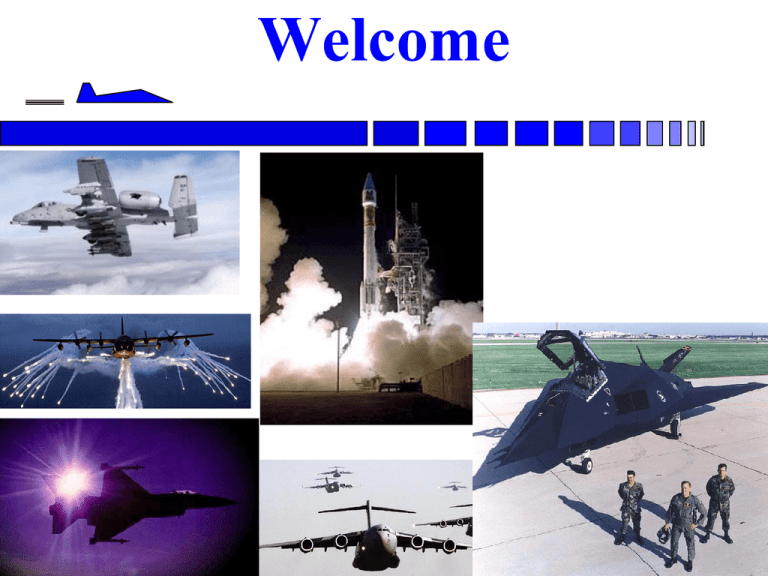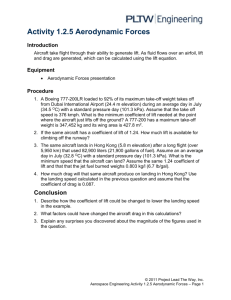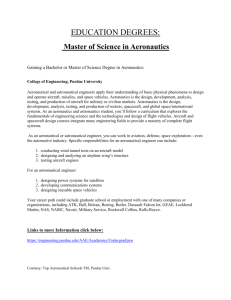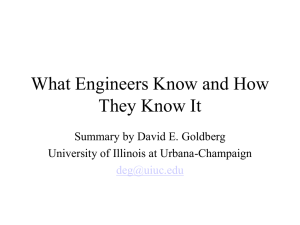Welcome
advertisement

Welcome What is Aeronautical Engineering? Physics of atmospheric flight Several sub-disciplines: + Aerodynamics + Propulsion + Stability and Control + Structures + Aircraft Performance = Aircraft (or Rocket) Design!!! Aeronautical Engineering: The Pilot’s Perspective Aeronautical Engineering: The Engineer’s Perspective Aeronautical Engineering: The Engineer’s Perspective Objective of Aeronautical Engineering Effectively and efficiently create and manipulate forces for flight Efficiently manipulate energy Aeronautical Engineering Designing extraordinary aircraft… Uncovering fascinating physical phenomena… Sometimes the engineer makes a mistake… Sometimes the pilot makes a mistake… AERODYNAMICS Aerodynamics In A Nutshell When a fluid moves about a solid surface, pressure and friction forces are created – Air may be considered a “fluid” just like water – Doesn’t matter if the fluid is moving past a stationary object or if the object is moving in a stationary fluid – Pressure and friction forces can help (“lift”) or hurt (“drag”) wind tunnels often used in design of aircraft open car window “wind tunnel” We control forces by changing or controlling the… – …shape of the object – …orientation of the object with respect to the flow – …relative speed of the object and the flow Goal: Lift overcomes Weight, Thrust overcomes Drag!!! Aerodynamics and the Laws of Physics Conservation of Mass – Mass can be neither created nor destroyed... – What happens when you hold your thumb over the end of a water hose? Conservation of Momentum - Newton’s Second Law – Time rate of change of momentum of a body is proportional to, and in the same direction as, the force (momentum is conserved) – Force = Mass x Acceleration Ideal Gas Law – Relates pressure, temperature, and density of gases – Pressure = Density x Temperature x Gas Constant Euler’s Equation (Momentum Equation for Fluids) F m dV mass x accelerati on dt General statement of Newton’s 2nd Law What it means: • force acting on an object is proportional to time rate of change of momentum dp VdV What it means: Euler’s Equation - Newton’s 2nd Law applied to a fluid Pressure Density x Velocity x Velocity • small changes in velocity make small changes in pressure and visa versa, or • as velocity increases, pressures drops (Bernoulli Principle) Airflow between two Styrofoam balls Application: Flow Past an Aircraft Wing Conservation of Mass - flow speeds up as streamlines get closer together – You’ll see a smaller space between smoke lines higher V! Euler’s Equation says static pressure must therefore decrease – higher V lower P! Pressure difference between upper and lower surfaces (higher pressure below wing) results in lift INTRODUCTION TO AIRFOILS & WINGS Airfoil Parts z Max thickness Max camber Mean camber line x Chord line Chord x=0 Leading edge x=c Trailing edge Airfoil Characteristics tip chord root chord leading edge sweep angle total wing area, S span, b tip chord root chord b2 aspect ratio S taper ratio Airfoil Forces and Moments Lift Aerodynamic Force Moment + V Drag Relative wind Angle of attack () : angle between relative wind and chord line Note: 1) lift is perpendicular to relative wind 2) drag is parallel to relative wind, not the horizon 3) moment is positive nose-up Effect of Angle-of-Attack A higher angle-of-attack results in increased lift (up to stall), but also increased drag L D stall zero lift L Wingtip Vortices low pressure high pressure Wingtip Vortices Contrails: A Vortex or a Cloud? INTRODUCTION TO STABILITY AND CONTROL Balance and Stability Examples Center of Gravity vs Aerodynamic Center Examples: Frisbee Ring Balsa wood airfoil Restoring Moments Desired Restoring Moment (-Mcg ) V Disturbance (+ a ) Restoring Moments V Displacement (- ) a Desired Restoring Moment (+Mcg ) Aircraft Axis System l x (Longitudinal Axis) An automobile has 2 degrees of freedom An aircraft has 6 degrees of freedom – 3 in translation (movement along each axis) – 3 in rotation (movement about each axis) m y (Lateral Axis) n z (Vertical Axis) Traditional Aircraft Controls All moving Elevators (Also called stabilator or tailplane) Ailerons (Flaperons) Rudder Aircraft Motions - Roll Roll: Motion about the longitudinal (X) axis produced by the ailerons Ailerons Aircraft Motions - Pitch Pitch: Motion about the lateral (Y) axis produced by the elevators Elevator Aircraft Motions - Yaw Yaw: Motion about vertical (Z) axis produced by the rudder(s) Rudder Stability and Control ?!? Sometimes you have it… yeah!!! Sometimes you don’t… ouch!!! The future??? Balsa Glider Moment Balance L L M l X ac X ac cg t t






